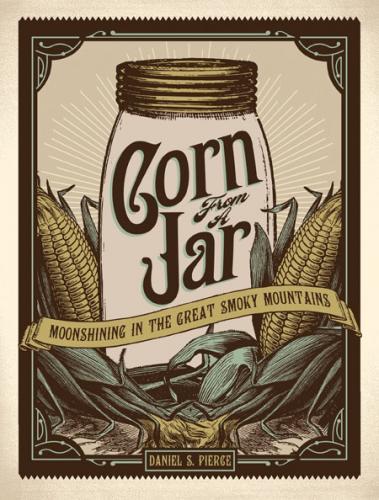By his own admission, Dan Pierce, author of Corn from a Jar: Moonshining in the Great Smoky Mountains, is an unlikely person to write about moonshine. His father was a Southern Baptist preacher in Asheville who may have never taken a drink. Ditto his mother. Pierce isn't much of a drinker himself.
Pierce, who grew up in Asheville, North Carolina, wrote a PhD dissertation on Great Smoky Mountains National Park; he's now the head of the history department at the University of North Carolina at Asheville. Pierce also is the author of Real NASCAR: White Lightning, Red Clay and Big Bill France. His research on NASCAR whetted his appetite to study the history of moonshine. The outcome was Corn from a Jar, a book delivered in a lively style with lots of anecdotes and many historic black-and-white pictures.
The book traces the making of moonshine from its beginning in the United States in the 18th century, when the Scots-Irish brought whiskey to the Southern Appalachians along with their skills for distilling grain. Here, they found clean, soft water, a good place to grow grain, and plenty of wood to heat their stills.
“It’s important to understand this regional phenomenon as the product not only of individual choices, but also of deep-seated cultural, economic and social conditions that created a complex and shifting historical context in which the moonshiners plied their trade,” Pierce said. His goal in writing Corn from a Jar was to humanize the moonshiner.
Settlers in the Smoky Mountains were never completely self-sufficient. They needed cash to pay for such goods as pots and pans as well as coffee and salt. Most important, they needed cash to pay their property taxes. Corn was difficult to transport on twisty, mountain roads. Distilled spirits brought in more money and was a lot easier to distribute in jugs. Until the Civil War, making whiskey was a tax-free, legal business.
But in 1862 Congress passed a law taxing whiskey. That tax started out at 20 cents a gallon, but it grew to two dollars by the end of the Civil War. Dr. Pierce points out that many larger operations registered with the government and became legal. But most Smoky distillers were transformed into outlaws and, in the popular press, moonshiners. They had to move their stills far up in the mountain hollows. The word "moonshine" became synonymous with the Southern Appalachian region as federal revenue agents played cat-and-mouse with illegal distillers.
But most moonshiners were sober, upstanding folks trying to provide for their families. They weren't the lazy, shiftless men emphasized in the popular press and in movies. In fact, many distillers didn't even consume alcohol; they felt that liquor's for selling, not for drinking. The temperance movement and later prohibition increased the demand for whiskey, especially in cities far from the mountains. Moonshiners cheapened the quality of the product, adding more sugar and less corn to their mixture.
Even the creation of Great Smoky Mountains National Park in 1934 didn't stop moonshiners. Superintendent Ross Eakin needed to use sensitivity and not violence when enforcing laws. Today, you'll occasionally come upon metal barrels on Smokies trails, now protected artifacts.
Dr. Pierce has great fun with the last chapter on modern legal moonshine resurrecting itself as a growth industry in the mountains. I stopped in downtown Gatlinburg, Tennessee, to try a sample at Old Smoky Distillery. It's a fun family attraction with a display of old-time moonshine equipment, but the alcohol tastes like bad medicine.
Two western North Carolina natives, one a history graduate from Dr. Pierce's class, started Howling Moon Mountain Moonshine just outside of Asheville, making traditional alcohol like their ancestors, but paying the taxes on it. On the other end of the spectrum, there's Popcorn Sutton, the last of the old-time moonshiner characters.
“Popcorn gave his fans what they wanted; the quintessential, bearded, salty, overall-and-flannel wearing, 'medlin’ guvmint'-hating, good-old-boy moonshiner topped off with a pork-pie hat with a raccoon’s penis bone stuck through the crown,” Dr. Pierce writes.
(In the interest of full disclosure, I've known Dan Pierce since I moved to Asheville 13 years ago. I took several courses from him at UNCA to kickstart my understanding of Southern Appalachian history and culture. I'm also not much of a drinker. A glass of wine with a good meal is as much alcohol as I can enjoy. You don't have to like whiskey to love this book.)
Corn from a Jar is published by Great Smoky Mountains Association, the non-profit cooperating association that supports Great Smoky Mountains National Park. Softcover copies are available for $9.95 and for $5.99 in a digital format on iTunes. Local western North Carolina bookstores, as well as all seven Great Smoky Mountains National Park stores, also carry the title.


 Support Essential Coverage of Essential Places
Support Essential Coverage of Essential Places






